European wine storage comes down to proven methods refined over centuries. You'll find French caves maintain perfect 10°C temperatures with 75-80% humidity, while Italian cantinas use hillside designs for consistent 45-64°F conditions. Spanish bodegas feature thick stone walls and underground chambers, keeping humidity at 65-72%. Portuguese cellars employ granite walls, and English country houses utilize vaulted layouts with double-height ceilings. Traditional techniques include German barrel preservation, Hungarian Tokaji upright storage, and Mediterranean underwater aging. Smart sensors now complement these time-tested approaches, though the core principles of temperature, humidity, and darkness remain unchanged. Exploring these methods reveals fascinating cultural traditions that still influence modern storage.
Traditional French Cave Storage Methods
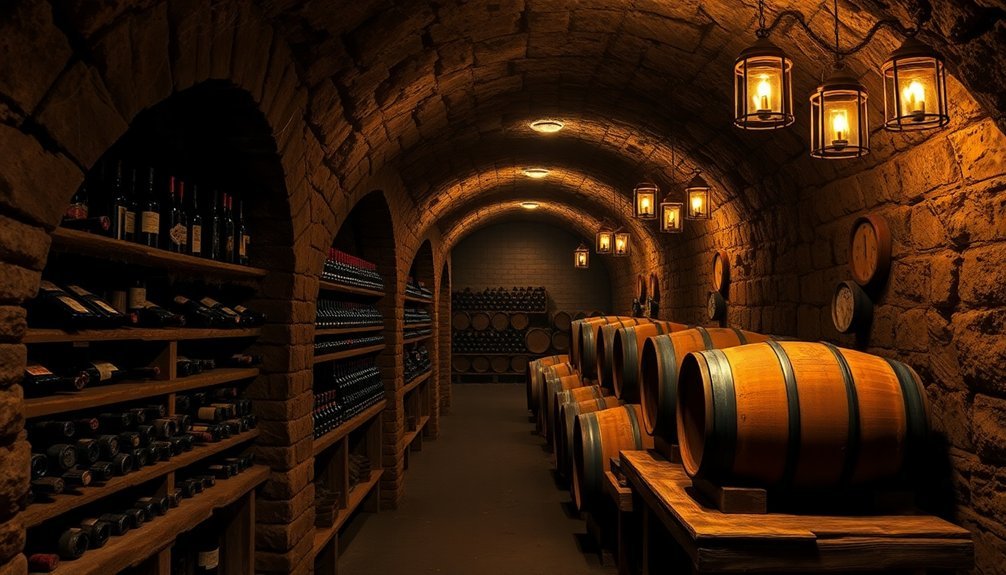
French wine caves represent centuries-old storage wisdom, perfected through generations of vintners and collectors. These underground storage facilities naturally maintain the ideal temperature of around 10°C (50°F), protecting wines from the damaging effects of temperature fluctuations that can lead to cork failure and premature oxidation. One of France's most impressive facilities, Les Caves Marly, spans an impressive 3 kilometers of underground galleries.
You'll find that French caves excel at maintaining ideal humidity levels between 75-80%, which is essential for preserving cork integrity and controlling the wine's aging process. The chalk quarries and rock formations that make up these caves naturally regulate moisture levels, preventing both cork drying and mold development.
The caves' underground environment offers perfect protection from light exposure, which can harm both red and white wines. You won't need to worry about photosensitivity issues that typically cause white wines to darken and red wines to fade. The natural darkness also preserves bottle labels, maintaining their historical and collection value.
For added protection, you'll notice that French caves often incorporate stackable storage systems with openwork walls to promote air circulation. They're typically equipped with security measures to protect valuable collections, and most maintain detailed records of their stored wines, including vintages and tasting notes.
Italian Cantina Temperature Control
Traditional Italian cantinas leverage underground natural cooling systems, typically built into hillsides or beneath buildings, to maintain the essential 45°F to 64°F temperature range.
To guarantee proper storage conditions, you should check your cantina's temperature twice daily using a reliable digital thermometer, once in the morning and once in the evening. A north-facing cantina provides optimal temperature control throughout the year.
Your temperature monitoring routine needs to account for seasonal changes and any variations caused by the opening and closing of doors, as these fluctuations can compromise cork integrity and wine quality.
Underground Natural Cooling Systems
Deep beneath the Italian countryside, traditional cantinas harness natural cooling principles to maintain ideal storage conditions for wines and spirits. By utilizing underground spaces, you'll find that these systems naturally maintain temperatures in the ideal mid-30°F range, similar to modern refrigerator settings.
The earth's insulating properties help prevent temperature fluctuations, which is essential for preserving wine quality. The underground environment naturally provides ideal humidity levels between 60% and 80%, protecting both wine corks and labels. Studies by Inter Rhone Technical Services have shown that wines stored at constant low temperatures perform significantly better over time.
You'll need to guarantee proper ventilation through at least two vents to maintain consistent air flow and prevent mold formation. This natural airflow system helps regulate both temperature and humidity while preventing the buildup of harmful gases.
Key benefits of underground storage systems include:
- Natural temperature control that stays consistently around 0-1°C without mechanical intervention
- Protection from light exposure, which can affect wine quality
- Vibration-free environment that prevents disturbance of wine sediments
When designing your underground storage, you'll want to position wine bottles horizontally to keep corks moist and functional. This traditional method has proven effective for centuries in maintaining ideal storage conditions without relying on modern technology.
Daily Temperature Monitoring Methods
Within successful Italian cantinas, daily temperature monitoring serves as the cornerstone of quality wine preservation. You'll need to maintain a consistent temperature of around 55°F (13°C), using reliable digital thermometers to track daily fluctuations. Check your storage area twice daily, focusing on morning and evening readings to catch any concerning patterns.
| Time of Day | Monitoring Action |
|---|---|
| Morning | Check temperature and record baseline |
| Midday | Monitor sunlight exposure and adjust covers |
| Afternoon | Review humidity levels and ventilation |
| Evening | Record temperature variations |
| Night | Verify cooling system function |
You'll want to place thermometers at different heights within your storage space, as temperatures can vary from floor to ceiling. If you're also storing cured meats, you'll need separate monitoring zones since they require cooler temperatures in the mid-30s°F range. Keep a daily log of your readings, noting any unusual spikes or drops. When you spot temperature fluctuations beyond 5°F, take immediate action by adjusting your climate control systems or relocating bottles to more stable areas.
Spanish Bodega Humidity Management
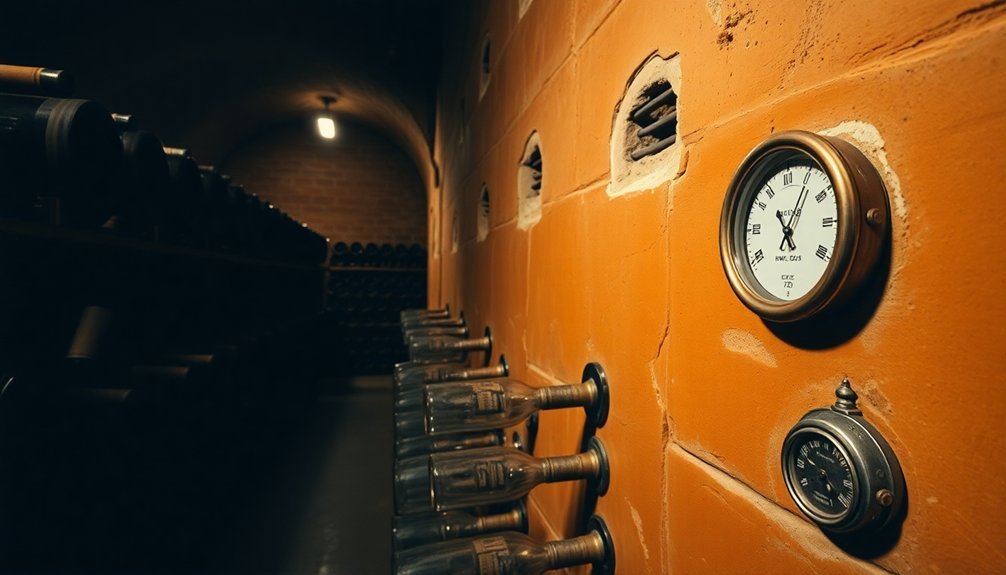
You'll find that Spanish bodegas have mastered humidity control through centuries-old techniques, including the strategic use of thick stone walls and underground chambers that naturally maintain moisture levels between 65-72%.
Traditional Spanish winemakers monitor their bodegas' humidity throughout the year using a combination of modern digital sensors and time-tested methods like observing condensation patterns on bottles.
The bodegas' natural climate control systems often incorporate unique architectural features such as high ceilings and ventilation shafts that work together to regulate humidity without mechanical intervention.
Monitoring Humidity Year Round
Spanish bodega masters understand that year-round humidity control forms the cornerstone of proper wine storage. To maintain ideal conditions between 50% and 70% humidity, you'll need reliable monitoring tools and consistent management strategies. Modern thermo-hygrometers with alert systems provide real-time data, guaranteeing you're always aware of your storage conditions.
For effective year-round monitoring, you'll want to establish these essential practices:
- Calibrate your hygrometers every few months to maintain accuracy within 5%
- Install wireless monitors with app connectivity for remote supervision
- Set up alert systems to notify you of any concerning fluctuations
When managing humidity levels, you can use cool-mist ultrasonic humidifiers during dry periods and dehumidifiers with humidistats when moisture levels climb too high.
If you're working with a natural cellar, adding gravel and occasional water sprinkling helps maintain stable conditions. For wine cabinets, humidity preservation systems using clay balls offer consistent control.
Don't forget to guarantee proper ventilation with constant air circulation, as this prevents mold growth and maintains ideal conditions. Regular inspections for signs of dampness or dryness should become part of your routine maintenance schedule.
Ancient Spanish Bodega Techniques
Ancient bodegas nestled throughout Spain's wine regions showcase remarkably effective humidity management techniques that have endured for centuries.
You'll find these underground passageways strategically designed to maintain ideal conditions for wine storage and aging, particularly in places like Quel, where complex networks of caves serve both practical and social purposes.
The architecture's brilliance lies in its multi-level design. You'll notice stone fermentation vats positioned at the entrance, typically two meters deep with massive capacities of up to 32,000 liters.
These vats connect to "pilas" – specialized cavities equipped with ladders – where you can collect and monitor the wine during fermentation. The back sections of these caves are perfectly suited for barrel storage, with recesses built to accommodate vessels of specific sizes: 90 and 200 pitchers.
You'll discover traditional "luceras" systems that transport grapes from hilltop to vat, while the cave's natural insulation maintains consistent temperature and humidity.
These ancient bodegas weren't just storage facilities – they're extensive winemaking environments where families gathered, featuring kitchen spaces and smoke flues that help regulate airflow and moisture levels throughout the cave system.
Natural Climate Control Systems
Maintaining ideal wine storage conditions doesn't require complex mechanical systems, as proven by traditional bodega designs that harness natural climate control principles.
By placing your wine cellar at least 15 feet underground, you'll naturally minimize temperature fluctuations throughout the year. You'll want to insulate exterior walls while leaving the floor uninsulated to take advantage of the earth's natural cooling properties.
To achieve best storage conditions like those found in traditional Spanish bodegas, focus on these key elements:
- Keep your red wines between 50-59°F and white wines between 45-50°F
- Maintain humidity levels between 50-70% using hygrometers for monitoring
- Allow proper air circulation by spacing racks away from walls
You'll need to adjust your humidity control methods seasonally. In winter, you'll likely need humidifiers to add moisture, while summer might require dehumidifiers to prevent excess humidity.
Install smart humidity sensors for real-time monitoring through your smartphone, making it easier to maintain consistent conditions.
Remember to avoid placing wine directly on the floor and make sure your storage layout promotes even air distribution throughout the space.
Portuguese Port Wine Cellar Design
The granite walls of Portugal's historic Port wine cellars tell a story of ingenious architectural design that's stood the test of time.
You'll find these traditional warehouses in Vila Nova de Gaia, where some structures have served winemakers for over 200 years. Their distinctive features – long halls, high ceilings, and thick granite walls – work together to maintain ideal storage conditions.
If you're examining modern Port wine storage, you'll notice how today's facilities blend traditional architecture with contemporary technology.
These warehouses use advanced insulation and moisture control systems to replicate the best 45-65°F temperatures and 60-75% humidity levels found in historic cellars. You'll see specialized tunnels where Vintage Ports age horizontally, keeping their corks moist and intact.
The cellar's design must protect wines from direct sunlight and heat sources while maintaining consistent environmental conditions.
You'll find wooden beams complementing the granite brickwork, creating a natural temperature regulation system.
Modern facilities like Quinta da Nogueira have enhanced these traditional elements with cutting-edge climate control technology, ensuring their Port wines develop the complex flavors and aromas that collectors prize.
German Wine Barrel Preservation
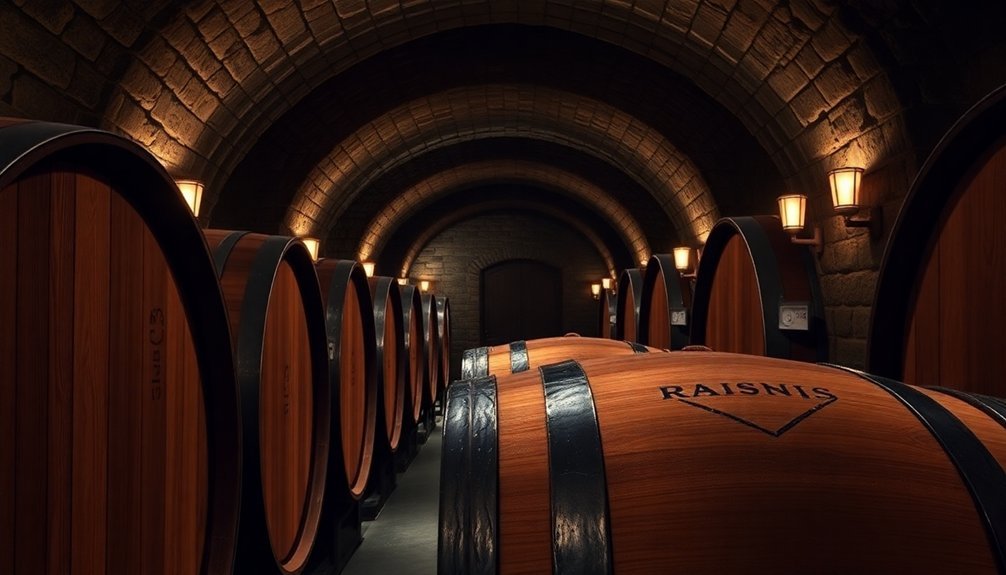
Deep within Germany's wine regions, proper barrel preservation stands as a cornerstone of quality winemaking. You'll need to maintain precise temperature and humidity levels (55°F, 65-75% humidity) to prevent wood shrinkage and protect your wine's quality.
For cleaning, start by filling your barrel with 3-5 gallons of hot, chlorine-free water at 180°F, rotating it thoroughly and letting it stand on each head for 4 hours.
When it comes to storage, you've got two reliable methods to choose from. For dry storage, you'll want to burn elemental sulfur inside the barrel using a sulfur bung, checking every 4-6 weeks. For wet storage, fill the barrel to 10% with an acidified SO2 solution, using 1 tsp citric acid and 1.5 tsp potassium metabisulfite per gallon.
Key maintenance points to remember:
- Always use silicone bungs to maintain SO2 gas integrity
- Rotate wet-stored barrels 45° when topping up solution
- Monitor pH levels – keep them below 3.0 to prevent mold growth
Regular inspection and prompt attention to any leaks or spoilage signs will guarantee your barrels remain in prime condition for wine aging.
Austrian Underground Storage Solutions
In Austria's premier wine regions, innovative underground storage solutions combine age-old traditions with modern engineering principles.
The New Austrian Tunneling Method (NATM) and Sequential Excavation Method (SEM) create vast underground spaces that reach up to 85 feet in width and 50 feet in height, utilizing room and pillar layouts for efficient construction and storage.
You'll find these underground caves maintain ideal wine storage conditions naturally. They keep temperatures between 55°F and 60°F while providing the high humidity levels necessary for proper aging.
There's no need to worry about sunlight damage or excessive vibration, as the earth's natural insulation protects your wine collection.
What makes these storage solutions particularly attractive is their efficiency. You're preserving valuable surface land for grape cultivation while reducing energy costs considerably compared to above-ground warehouses.
Multiple portal entrances ensure both safety and operational convenience, and you can use these spaces for various winery operations, from crushing to bottling.
The facilities often feature distinctive architectural elements like octagonal rooms and domed chambers, making them suitable not just for storage but also for public tours and tastings.
Greek Island Wine Protection
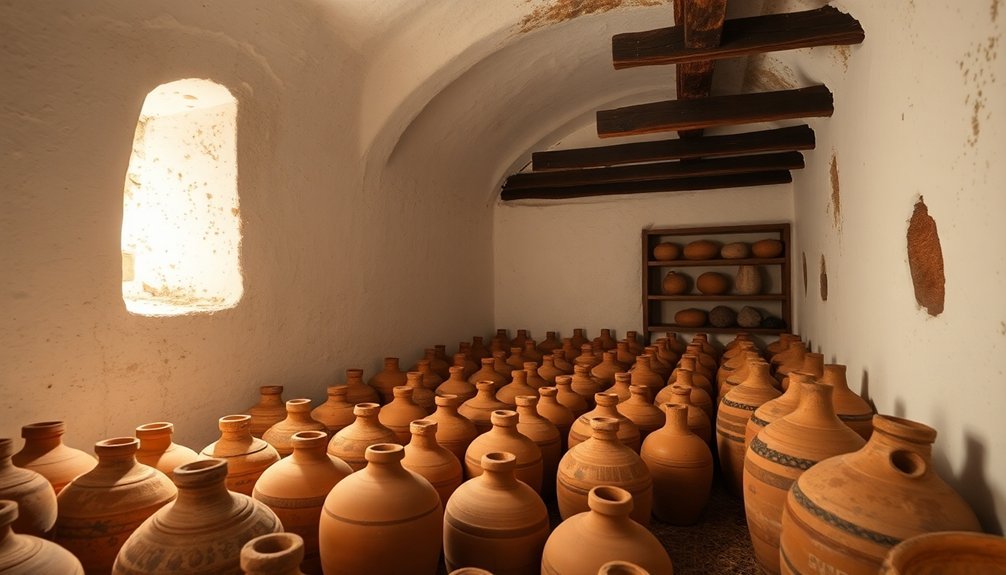
While Austria's underground caves offer modern storage solutions, Greek islands have protected their wines through time-tested methods passed down through generations.
You'll find that regions like Chios, Lesvos, and Corinth developed sophisticated protection methods that guaranteed their wines' quality and authenticity.
The Greeks understood the importance of proper storage vessels, using clay amphorae coated with natural materials like beeswax or animal fat to create impermeable containers.
You can still see evidence of their innovative approach in these traditional practices:
- Ground burial of wine jars for ideal temperature control and fermentation
- Natural cooling techniques using shaded areas, complemented by ice and snow when available
- Strategic use of heliasterion rooms for 13-month sun exposure aging
You'll notice that Greek islanders were pioneers in wine protection legislation too.
Thassos implemented early laws prohibiting wine adulteration, similar to today's Protected Designation of Origin standards.
They even experimented with unique preservation methods, including the addition of seawater, which they believed made wines more digestible and lighter in character.
English Country House Cellaring
You'll find that English country house cellars masterfully regulated temperature through their thick stone or brick walls and below-ground construction, maintaining ideal conditions between 45°F and 64°F year-round.
The vaulted storage layout wasn't just for show – these arched ceilings provided vital structural support while maximizing the usable space for wine and spirit storage.
The design often incorporated external entrances on sloping sites, allowing natural light to filter in while maintaining the cellar's essential cool environment.
Natural Temperature Regulation
England's historic country houses have long mastered the art of natural wine storage through their traditional cellaring methods. These grand estates typically feature underground cellars with beaten earth floors and thick stone walls, providing excellent natural insulation that maintains temperatures between 10°C and 14°C year-round.
You'll find that the best country house cellars utilize natural elements to regulate temperature and humidity without modern technology. The limestone construction common in these cellars helps maintain stable conditions, while the underground location shields wine from harmful temperature fluctuations and direct sunlight.
To achieve ideal storage conditions in a traditional cellar, you'll want to focus on these key elements:
- Position your wine storage away from any heat sources or areas with significant temperature changes
- Keep bottles on their sides if they're cork-sealed to prevent the cork from drying out
- Maintain humidity at around 70% by occasionally spraying water on the earth floor
The beauty of these traditional cellaring methods lies in their simplicity – they're remarkably effective at maintaining consistent conditions.
You don't need complex systems when the natural properties of underground stone construction work so efficiently to protect your wine collection.
Vaulted Storage Layout
Traditional vaulted storage layouts in English country houses combine aesthetics with functionality through carefully designed architectural elements. You'll find double-height ceilings paired with Umbrian limestone that create an authentic cellar environment while providing superior storage conditions for your collection.
The layout incorporates modular designs that you can customize to your specific needs. You're able to configure storage spaces with adjustable shelving made from stained grey oak and solid wood units, complete with brass handles for a classic touch.
The Modulo-X and Modulothèque systems let you adapt the layout to any room constraints, reaching heights of up to 3.40m when fastened to walls or ceilings.
Your vaulted storage can include dedicated spaces for wine cases, single bottles, and even separate compartments for cigars and liquors. The design features UV-stable tinted frameless glass doors that protect your collection while creating an impressive display.
You'll appreciate the clever backlighting and bottle presentation options that enhance the visual appeal. The integration of Wine Guardian conditioning units ensures your collection maintains perfect temperature and humidity levels, while the lockable design and switch-glass doors provide essential security.
Hungarian Tokaji Storage Techniques
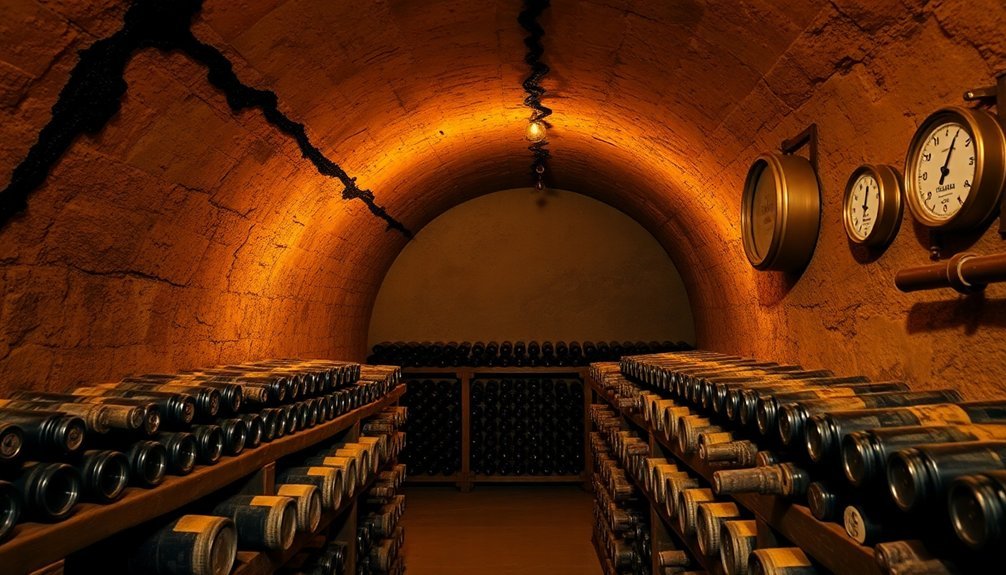
Deep beneath Hungary's rolling hills, Tokaji wine storage follows unique protocols that set it apart from conventional wine preservation methods. While most wines require horizontal storage to keep corks moist, you'll find Tokaji bottles standing upright in Hungary's historic cellars, where exceptionally high humidity levels around 95% prevent cork drying.
To maintain your Tokaji collection properly, you'll need to focus on these critical storage conditions:
- Keep temperatures steady between 55-60°F (13-15°C) to prevent premature aging and preserve the wine's delicate balance.
- Confirm storage areas remain dark and vibration-free, protecting the wine from light damage and unnecessary disturbance.
- Maintain consistent humidity levels between 70-80% if you're storing at home, as you won't have the natural cellar mold that stabilizes Hungarian caves.
For long-term storage, you'll need to monitor your bottles regularly and plan for recorking every few decades.
If you can't replicate the high-humidity conditions of traditional Hungarian cellars, it's best to store your Tokaji bottles on their side.
Remember to keep them away from strong odors that could affect the wine's character through the cork.
Mediterranean Coastal Wine Safekeeping
Down along the Mediterranean coast, innovative winemakers have revolutionized aging techniques by turning to the sea itself for wine storage. You'll find their bottles resting in metal cages or terracotta amphoras at depths between 18-60 meters, where constant temperatures of 10-13°C create perfect aging conditions.
The sea provides unique benefits you won't find in traditional cellars. The gentle rocking of waves enhances aging, while the underwater environment shields wine from light, oxygen, and moon phases. Leading wineries like Tenuta del Paguro and Gaia Wines have embraced this method, aging their wines for 6 months to 5 years beneath the waves.
| Location | Depth | Storage Method |
|---|---|---|
| Ravenna Coast | 60m | Sunken Oil Platform |
| Santorini | 25m | Metal Cages |
| Croatia | 18-25m | Terracotta Amphoras |
This storage method isn't just innovative – it's scientifically sound. You're getting the same benefits ancient winemakers sought when they buried kvevris underground: stable temperatures, reduced oxygen exposure, and perfect humidity levels. The marine microclimate, complete with shellfish habitats, adds an extra layer of uniqueness to these Mediterranean wines.
Frequently Asked Questions
How Long Can Wine Be Stored Before the Cork Needs Replacing?
You don't need to replace your wine cork unless there's visible damage or leakage. With proper storage conditions, quality corks can last 20-80 years while effectively protecting and aging your wine.
Can Different Types of Spirits Be Stored Together in the Same Cabinet?
You can store different spirits together in the same cabinet, as long as you maintain consistent temperature (54-64°F) and moderate humidity (50-80%). Just guarantee they're kept upright if cork-sealed and away from sunlight.
What Materials Are Best for Wine Rack Construction in Humid Environments?
You'll find that metal, plastic, and certain woods like white oak and western red cedar are your best options for humid environments. They're resistant to moisture damage and won't promote mold growth.
How Does Altitude Affect Wine Storage Requirements and Aging Process?
While altitude won't directly affect your wine's quality, you'll need stronger climate control at higher elevations. You'll notice slower wine "opening" due to lower oxygen levels, but proper storage conditions remain the same.
Should Wine Bottles Be Rotated Periodically When Stored for Extended Periods?
You don't need to rotate your wine bottles during storage. It won't prevent sediment formation or improve wine quality. Instead, focus on maintaining proper temperature, humidity, and keeping bottles stored horizontally for best results.
In Summary
You'll find these European storage methods offer time-tested wisdom for preserving your wines and spirits. Whether you're adopting the French cave's careful temperature control or the Spanish bodega's humidity management, you're tapping into centuries of expertise. Start with the method that best suits your climate and space, then adapt as needed. Remember, proper storage isn't just about preservation – it's about enhancing your collection's quality over time.





Leave a Reply